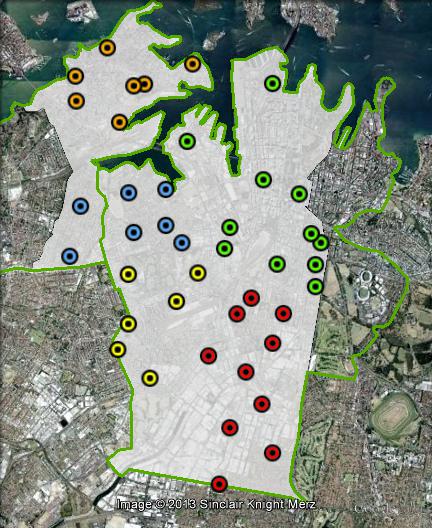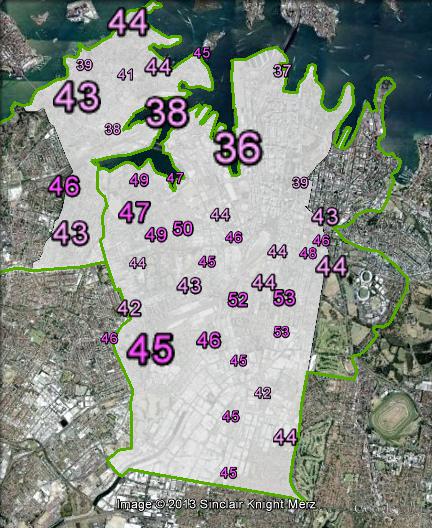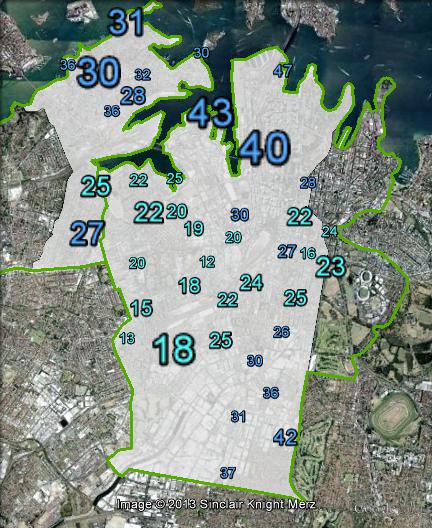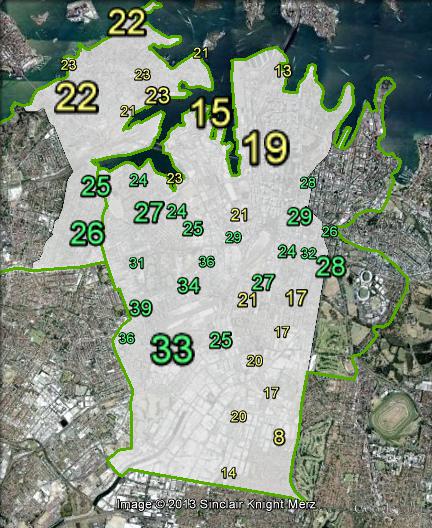ALP 17.1%
Incumbent MP
Tanya Plibersek, since 1998.
Geography
Inner suburbs of Sydney. Sydney covers most of the City of Sydney and parts of the Leichhardt council area. The seat covers the Sydney CBD, Pyrmont, Ultimo, Surry Hills, Redfern, Waterloo, Alexandria, Erskineville, Glebe, parts of Newtown, and the southern parts of the City of Sydney, extending as far south as Rosebery.
The seat also covers Annandale and the Balmain peninsula, including the suburb of Rozelle. Sydney does not cover eastern parts of the City of Sydney such as Kings Cross and Darlinghurst, which are included in Wentworth.
History
Sydney was created for the 1969 election by the merger of the seats of East Sydney and West Sydney, which had existed since federation.
Sydney has been held by the ALP ever since its creation, and its predecessors had almost always been held by Labor.
West Sydney (which, despite its name, actually covered inner city suburbs like Darling Harbour and Pyrmont) always elected a Labor MP, although it was briefly held by a conservative party from 1916 to 1917, as its first MP was Billy Hughes, who as Prime Minister left the ALP and formed the Nationalist party. He proceeded to move to a different seat at the 1917 election, and the ALP held West Sydney from 1917 until its abolition, although Jack Beasley, who held the seat for eighteen years, left the ALP to join a Lang Labor breakaway party on two occasions in the 1930s and 1940s.
The seat of East Sydney was first held by George Reid, a former NSW premier and leader of the Free Trade party, from 1901 to 1909, when he retired. John West (ALP) won the seat in 1910 and held it until his death in February 1931. The ensuing by-election was won by Eddie Ward, who left the ALP later that year when he was one of a number of supporters of NSW Labor leader Jack Lang to cross the floor and bring down the Scullin government.
East Sydney was won at the 1931 election by John Clasby (UAP) who benefited from a split Labor vote, with the two Labor parties gaining 55% of the primary vote but enough preferences from the official ALP leaking to Clasby to see Ward lose. Clasby died a month later without taking his seat and Ward won back the seat at a January 1932 by-election, less than a year after he had previously won the seat at a by-election. Ward returned to the ALP in 1936 and the ALP held the seat from then until its abolition in 1969.
The new seat of Sydney was first won in 1969 by Jim Cope. Cope had previously held the seats of Cook and Watson before their abolitions. Neither seats have any connection to the modern seats with those names. Both Cook and Watson had covered parts of South Sydney now covered by Sydney. Cope had won Cook at a 1955 by-election following the death of the previous member, but the seat was abolished at the general election in the same year. Cope then held Watson from 1955 until it too was abolished in 1969, at which point he moved to the new seat of Sydney.
Cope held Sydney until 1975, and served as Speaker of the House of Representatives from 1973 until a dispute with the Whitlam government saw him resign in protest in 1975.
Cope was succeeded in 1975 by Leslie McMahon (ALP), who served until he was defeated for preselection before the 1983 election.
The seat was won in 1983 by Peter Baldwin, previously a Member of the Legislative Council who had become a symbol of the conflict between the Left and Right within the ALP in the Inner West in 1980 when he was brutally bashed in his home. Baldwin served as a federal minister from 1990 to 1996 and retired at the 1998 election.
The seat has been held since 1998 by Tanya Plibersek, who has served as a minister since the 2007 election. Plibersek served as Housing Minister in the first term, then as Minister for Human Services from 2010 until 2011, and as Health Minister since 2011.
The seat has always been considered a very safe Labor seat according to the two-party-preferred vote, but has recently become one of the strongest Greens seats in the country. The seat of Sydney has seen votes for the Greens of over 20% at the last three elections, and was the top-polling seat for the Greens at the 2004 election.
Candidates
- Jane Ward (Independent)
- Sean O’Connor (Liberal)
- Peter Boyle (Socialist Alliance)
- Lesley Mason (Christian Democratic Party)
- Joanna Rzetelski (Independent)
- Timothy Daniel Kelly (Palmer United Party)
- Leah Gartner (Bullet Train For Australia)
- Dianne Hiles (Greens)
- Tanya Plibersek (Labor)
Assessment
Sydney’s 17.1% margin is misleading, as the main competition to Labor comes from the Greens, not from the Liberal Party. If the Greens were to overtake the Liberal Party, and preference flows from the Liberal Party were similar to those in Melbourne and Grayndler, than the Greens would be very close to winning.
Despite these underlying strong conditions for the Greens, it’s unlikely to happen in 2013. Even if the Greens’ vote goes up, which is possible, the Greens are unlikely to close the 4.35% gap with the Liberal Party in circumstances where the Liberals should also gain a solid swing.
The decision of the Liberal Party to preference the ALP ahead of the Greens has closed any window of opportunity for the Greens to win.
2010 result
| Candidate | Party | Votes | % | Swing |
| Tanya Plibersek | ALP | 34,362 | 43.29 | -5.92 |
| Gordon Weiss | LIB | 22,307 | 28.10 | +1.20 |
| Tony Hickey | GRN | 18,852 | 23.75 | +3.44 |
| Brett Paterson | DEM | 1,256 | 1.58 | +0.48 |
| Jane Ward | IND | 1,226 | 1.54 | +0.30 |
| Christopher Owen | SEC | 718 | 0.90 | +0.90 |
| Denis Doherty | COM | 656 | 0.83 | +0.83 |
2010 two-candidate-preferred result
| Candidate | Party | Votes | % | Swing |
| Tanya Plibersek | ALP | 53,235 | 67.07 | -2.25 |
| Gordon Weiss | LIB | 26,142 | 32.93 | +2.25 |

Booth breakdown
Booths have been divided into five areas, based on the key suburbs: Balmain, Annandale-Glebe, Newtown-Erskineville, with the remainder divided into Inner Sydney and South Sydney.
The ALP topped the poll in all five areas, varying from 41% in Inner Sydney to 47.4% in South Sydney. The Liberal vote varied from 16.5% in Newtown-Erskineville to 32.1% in Inner Sydney. The Greens vote varied from 18.8% in South Sydney to 34.8% in Newtown-Erskineville.
| Voter group | GRN % | LIB % | ALP % | Total votes | % of votes |
| Inner Sydney | 22.07 | 32.05 | 41.01 | 16,273 | 20.50 |
| South Sydney | 18.76 | 29.23 | 47.37 | 11,597 | 14.61 |
| Annandale-Glebe | 25.31 | 23.12 | 46.85 | 11,015 | 13.88 |
| Balmain | 22.08 | 31.27 | 42.79 | 10,348 | 13.04 |
| Newtown-Erskineville | 34.81 | 16.50 | 43.97 | 7,878 | 9.92 |
| Other votes | 23.66 | 29.73 | 41.06 | 22,266 | 28.05 |





$1.10 that Plibersek cries on TV on election night?
Only fools gamble
Fear not, fellow Sydney constituents! I see from the AEC website that Jane Ward is running, and has in fact secured top spot on the ballot paper.
No Australian Democrats candidate, though! That’s a first for this electorate. Does anyone know about the other candidates that have cropped up; eg Independent Joanna Rzetelski or “Bullet Train” candidate Leah Gartner?
No Democrats in Melbourne Ports either – also a first as the last Democrats leader Lyn Allison lives in that electorate.
There is a Bullet Train candidate in Indi were my sister lives. Perhaps they are standing candidates in a proposed route for the fast “choo choo”. Is Tim Fisher involved?
Interesting to see that Plibersek is running a reasonably resourced campaign – weekly letterbox drops (not direct mail, but good profile raising etc); volunteers occasionally seen out and about (but not as much as the Greens or Liberals). This isn’t tons of money, but more than Labor will have spent here in the past. The Liberal campaign is better resourced than in recent memory, suggesting TP wants to maintain her margin this time.
Well, it’s been a very quiet local campaign here. Just got my first Greens flyer in the mail. Apart from the postal vote application form, nothing from the Libs. Three leaflets from Tanya Plibersek. Nothing from any other candidate. Plenty of Greens and Labor posters to be seen, but no Liberal posters until Sunday, in my suburb. A few CDP posters, and that’s it. Here’s my predictions for Saturday:
1.9 Ward (same as last time, plus a bit of donkey vote)
32.5 Liberal (possibly ambitious… anything more than 30.1 is a new record for this seat)
0.8 Socialist Alliance (Communist vote from 2010)
1.0 Christian Democratic Party (enough of a local campaign to crack 1% IMO)
0.7 Rzetelski (seems OK on her website, but no resources and no campaign)
1.1 Palmer United (celebrity/protest vote)
0.6 Bullet Train (do you want your Federal representative to be single issue?)
21.2 Greens (bit of a drop in line with opinion polling generally)
40.2 Labor (may drop more, but I just can’t imagine a figure with a “3” in front of it)
Millers Point to be won by the Liberals, possibly Pyrmont plus one of the Rosebery booths.
Well, that’s on the record now. Any other Sydney voters out there care to make predictions?
Not bad, GNav, I’m impressed!
This is quite an unnusual seat – an impressive swing to Labor (against the national trend) and a bigger than average swing away from the Greens.
Any explanations? One thing for sure, all those what claimed disaffected Labor voters (PNG) would shore up the Greens vote this time have some head-scratching to do. In the Greens inner city Sydney “heartland” (Grayndler, Kingsford Smith too), the Greens vote declined either in line with the national average, or greater.
I suspect that given the large seat-to-seat varation in the base Greens vote, you need to compare relative swings rather than absolute. The Greens vote fell more in Sydney in absolute terms because there were more Greens voters there to begin with.
Possibly Plibersek had a strong personal profile. Possibly the district is becoming more aspirational and less welcoming to left-left style of candidates.
Disappointing (I say as a Lib).
he Liberals did well in the northern end of the electorate – Balmain booths all moving by 5% net, and by narrowly winning Pyrmont. However that was offset by a few 2pp swings to Labour in the south and west of the electorate. As ever in a seat like this, Labor outspent the Liberals considerably, but the Liberal campaign was rather more extensive than in the past. I suspect Labor’s on the ground sand-bagging, and especially flooding the electorate with polling booth workers (GetUp, Greens and Labor each outnumbered the Liberal helpers across the day) stemmed the tide.
Well, I’m pretty happy with my predictions, although I didn’t think the Labor vote would go up, or the Greens vote drop so sharply. Pretty happy with my micro-party picks, and the booth calls: Millers Point, Pyrmont and Rosebery all won by the Liberals.
There’s one big anomaly I’d like some help with… the result in Birchgrove. Primary votes up 3% each for Libs and Labor, but TPP says a massive 14% swing to the Liberals? Did all the Greens voters in Birchgrove suddenly decide to preference the Liberals? This looks so weird I actually think there is some kind of mistake in the votes as shown.
Not a Labour voter but Tania is a class act unlike that ex NSW Police Inspector King who wanted to ban the burqa. That idiot lost ha, ha, ha.
A closer look at the TPP results and swings by booth tells a fascinating story. We may be one electorate, but we are tearing apart into two quite distinct areas, politically speaking. The short version is this: areas with already higher Liberal votes saw bigger pro-Liberal swings; areas with very low Liberal votes were static or swung against the Liberals.
Across the top of the electorate, the Liberals have won Millers Point and Pyrmont, and are in striking distance of winning Birchgrove, Rozelle East, Sydney Town Hall and Balmain. In the south-east corner, Rosebery has fallen, and Zetland South and Rosebery West are within reach.
But – go to Darlington, Newtown, Glebe, Erskineville, Forest Lodge, Camperdown, Alexandria, parts of Ultimo closer to Sydney Uni… another story altogether. Annandale seems to sit in the middle, while Surry Hills seems to be in the process of shifting.
Of course, it’s all about demographics. Once upon a time, the Labor vote in Balmain and Pyrmont was exactly the same as the Labor vote in Newtown or Alexandria. That seems a world away now. So – Pyrmonter – you shouldn’t feel disappointed. Demographic change is slow, but we can see it unfolding before our eyes.
GNav – demographics, but up to a point. I struggle to perceive a significant demographic difference between northern Glebe and, say, Rozelle East. I think you’re on to something about Zetland and Waterloo, and the changing population is more obvious there.
Rozelle East makes a very interesting case study of demographic change. I lived in the catchment area of this booth and voted here in 2007. As the location previously was slightly different, this booth used to be known as Bald Rock.
Number of votes cast here was >600 in 1984, dropped to 60% here in 1993, and their primary vote has only dropped below 50% twice, in 2001 and 2010. A falling Greens vote in 2013 saw Labor achieve a 52.6% primary vote across the four Glebe booths, very close to their 2007 result.
What is interesting is that, after three elections in third place, the Liberals out-polled the Greens across Glebe for the first time since 2001, with 22.1% to 19.4%. Glebe hasn’t seen an influx of upwardly mobile new residents – yet. Have a think about those Mirvac developments racing towards completion at the old Harold Park, though. When they are complete, and the new residents have moved in, I rather suspect that will have a positive impact on the Liberal vote in that part of Glebe!
Sorry – a gremlin in the computer ate a big chunk of the middle of that comment. It should read:
Number of votes cast here was >600 in 1984, dropped to 700 in 2007 and 2010, but moving the booth from the old Smith Street school to the C3 church has made it slightly more inaccessible).
The influx of new voters has come from the new apartment complexes around Hyam Street, Foy Street and Buchanan Street. The area was once the Unilever factory, filled with Labor-voting workers who lived in surrounding cottages. Now it is residential, and look at the results:
Liberal primary vote leaping past the 30% mark in 2004, and now charging past the 40% mark. Labor primary vote dropped below 50% in 1996, and below 40% in 2010. This year it has drifted lower, to just under 37%, and so history has been made – Liberals out-polling Labor at this booth for the first time ever.
The Greens vote here was at its lowest since 1998. Clearly the influx of new residents has boosted the Liberal vote. With the Labor TPP reduced to 51.17%, this booth will return a Liberal majority in 1-2 elections.
Glebe is much more stable politically, with a Liberal primary vote in the high teens and low twenties for many years now. Their 22.1% primary vote (across the four Glebe booths) in 2013 was similar to 2001, and a bit lower than their 1987 result.
Labor are very strong here; their primary vote was still >60% in Glebe in 1993, and it has only dropped below 50% twice, in 2001 and 2010. A falling Greens vote in 2013 saw Labor achieve a 52.6% primary vote across the four Glebe booths, very close to their 2007 result.
Obviously the really interesting aspect of this seat and neighbouring ones will be how much they change in the next redistribution which is most likely to occur in 2015 for NSW, if my understanding is correct. NSW is expected to lose a seat to WA with Page & Richmond most likely being merged and others seats adjusted accordingly.
AG wrote a piece on this, http://blogs.abc.net.au/antonygreen/2013/05/prospects-for-federal-redistributions-in-the-2013-16-parliament.html#more
I think that you did an amazing job with your predictions GNav!!! I have posted the actual vote (as 10/09) prior to your prediction for ease of comparison. Your SA & Rzet are almost exact and most others are within range. With a track record like that you could go get snapped up be an agency or a party!
GNav: “Here’s my predictions for Saturday:”
1.47 1.9 Ward (same as last time, plus a bit of donkey vote)
30.04 32.5 Liberal (possibly ambitious… anything more than 30.1 is a new record for this seat)
.75 0.8 Socialist Alliance (Communist vote from 2010)
.78 1.0 Christian Democratic Party (enough of a local campaign to crack 1% IMO)
.68 0.7 Rzetelski (seems OK on her website, but no resources and no campaign)
1.36 1.1 Palmer United (celebrity/protest vote)
.84 0.6 Bullet Train (do you want your Federal representative to be single issue?)
17.32 21.2 Greens (bit of a drop in line with opinion polling generally)
46.76 40.2 Labor (may drop more, but I just can’t imagine a figure with a “3″ in front of it)
Redistribution-wise, the Page-Richmond combination is only a thing for if an election gets called in the middle of the redrawing (read Antony’s article again.) For an actual full redrawing of NSW, both seats would expand south and west, but where to exactly depends on whether the abolished seat is in Sydney (Lowe, 2010), regional NSW (Gwydir, 2007), or somewhere else again (it might be something complicated, like one of the central coast seats abolished to create two new ones). It’ll also depend on just how big they think Farrer and Parkes need to get.
Given that a Sydney seat was abolished last time, it’s highly likely that it would be another rural electorate to disappear this time.
Thanks Bird of paradox, I obviously didn’t read AG’s piece so well – just had a memory he had written something a while back – and only scanned through it. I did think it was a little strange that he was nominating the specific seat to go/seats to be merged for a redistribution.
Anyway, where ever the seat is abolished it will be interesting to see how these inner city seats are adjusted and if with a combination of demographic changes it potentially makes a seat like this marginal in a a couple of elections. It will be interesting what the majors propose to the AEC for new seat boundaries.
GNav – but unless I’m missing something, most of northern Glebe is owner occupied, “front door facing the street” housing, often with harbour views – not normally a bad demographic for the Libs – I think this must be one of the ALP’s best 2pps for a harbourside booth.
I don’t reckon the inner-city electorates would need to change all that much (especially they’re bounded by the coast). If their population is growing faster than NSW in general, the redistribution won’t need to touch them when one seat is abolished and all others need to gain population from somewhere – they will already be close to the right amount. It’s the mirror image of O’Connor and Durack (WA), which have a dwindling population but are in a state gaining a seat, so all existing seats need to shed population.
Wentworth, Sydney and probably K-S will still be over quota even if a seat is abolished. They are well above quota now and presumably still growing.
Wentworth will probably move back out of the inner city and down the coast, with Sydney moving eastwards. This would likely unite the Newtown area in Grayndler, which would be very good news for the Greens there.
I think the most sensible option for Grayndler is to add the rest of Leichhardt Council to that district, but NFI if the numbers add up properly.
Turnbull’s district will probably have a 20%+ 2PP after the next redistribution.
IDK about growing quotas, but the best option on current quotas might be to eliminate a seat north of Sydney.
Otherwise, you could get rid of a dog’s breakfast district like Throsby.
Here is candidate Dianne Hiles’ explanation for the embarrassing –6.3% against the Greens. It was “the media’s” fault:
http://www.dailytelegraph.com.au/newslocal/city-east/tanya-plibersek-retains-sydney-but-laments-labor8217s-national-loss/story-fngr8h22-1226714387620
Of course it was! The very same media that went for Labor’s jugular. The very same media that then actually increased Labor vote by 3.2% in this seat… One thing for sure, politicians in defeat (yes you Dianne) really shouldn’t say anything.
Yeah, Senator Milne saying that Labor’s leadership problems contributed to her party’s drop in vote was a bit of a long bow too. I would be more impressed if they just owned the drop and said that they would be examing why their vote was down and how to address it.
Just quickly, I checked the AEC website and noticed that the strange result for Birchgrove, which had shown a 14% swing to Liberals, has now been changed to a much more sedate 1.94% pro-Liberal swing, which leaves Birchgrove a safe Labor booth. I wonder what happened there?